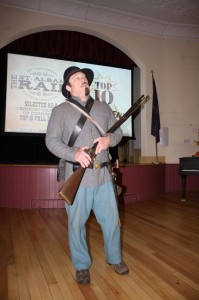
Steve Smith, of St. Albans, is an officer with the 2nd Mississippi and the organizer of the re-enactors that will camp in Taylor Park in September.
Visitors to the St. Albans Raid 150th Anniversary Commemoration will rub shoulders with re-enactors, both civilian and military. These volunteers work hard to bring the period back to life.
Steve Smith, of St. Albans, is an officer of the 2nd Mississippi, which will have an encampment on Taylor Park. He has organized the overnight stays of re-enactors from around the region who will camp in Taylor Park.
Here is Smith’s synopsis of the numerous units that will appear in this living history event, about 80 soldiers in all.
Union Order of Battle
- 2nd Vermont – Originally, a three- year regiment in the Union army, the 2nd Vermont has as its roots various Vermont militia companies from Burlington, Ludlow, Castleton, Fletcher, Montpelier, Tunbridge, Vergennes, and Waterbury. It was one of the first units organized after Lincoln’s initial call for volunteers. It later became the foundation of the famous “Vermont Brigade”, and participated in many engagements during the war most notably 1st Manassas, Wilderness, and Pickett’s Charge at Gettysburg. Today, the 2nd Vermont calls its home HQ as Burlington, Vermont
- 118th New York – The 118th New York infantry was recruited from Clinton, Essex, and Warren counties in northern New York and became known as the “Adirondack Regiment.” The unit saw action along the Atlantic Coast in the Department of Virginia before being transferred to the Army of the James in 1864. The 118th participated in the Overland Campaign and the siege at Petersburg. The 118th New York has the distinction of being the first organized Union unit to enter Richmond after retreating Confederates abandoned it in 1865. Today, it remains in the Adirondack area calling its home as Tupper Lake, New York
- 1st Vermont Cavalry – Mustered on November 19, 1861 in Burlington, Vermont, the 1st Vermont Cavalry served in the Cavalry Corp of the Army of the Potomac. It served in approximately 76 engagements from Mount Jackson on April 16, 1862 to Appomattox on April 9, 1865. This included the Shenandoah Campaigns, Gettysburg Campaign, Overland Campaign, plus many skirmishes not connected a larger action. The 1st Vermont Cavalry is most remembered by its gallant but failed charge against the Confederate right flank on the 3rd day at Gettysburg. The unit’s heritage continues today with a state legislative decree naming the Norwich University Corps of Cadets as members of the regiment. The modern re-enactor HQ is in the Shoreham-Orwell, Vermont area.
- 1st US Dismounted Cavalry – Not designated as a state unit, the 1st US Dismounts was raised from several states throughout New England. It saw heavy action at Gettysburg and at the Wilderness. As with most Union cavalry units, the 1st US Dismounts were armed with repeating rifles and served mostly as skirmishers and as a rear guard protecting the main body of troops. Today, the unit will travel up from Connecticut to join the 150th St Albans Raid Anniversary.
Confederate Order of Battle
- 2nd Mississippi – Probably one of the most storied Confederate units, the 2nd Mississippi is credited for giving Thomas Jackson the famous Stonewall nickname at the first battle of Manassas. The 2nd was side by side with Hood’s Texans in the cornfield at Sharpsburg. The 2nd Mississippi saw heavy action at the Gettysburg railroad cut inspiring Don Troiani’s artwork “Fight For The Colors.” The 2nd did not survive the war ceasing to exist shortly after the Petersburg defenses broke apart in April 1865. The unit was originally formed in the vicinity of Riley, Mississippi and today has its HQ in St Albans.
- 10th Louisiana – Known as Lee’s “Foreign Legion,” the 10th Louisiana was unique because most of its soldiers were from Greece, Italy, Spain, France, and over a third being Irish. The 10th saw notable action at Williamsburg, Cold Harbor, and participated in several unsuccessful attacks at Culp’s Hill at Gettysburg. Later, the 10th was involved in the Overland Campaign and saw action with General Early in 1864 in the Shenandoah. The 10th Louisiana was a mere shell of its former self when it stacked arms at Appomattox. Today, the 10th Louisiana makes its home in the vicinity of Kitchener, Ontario
- 12th Georgia – The 12th Georgia completed its organization in June 1861 in Richmond, Virginia. Its soldiers were raised mostly from Sumter, Jones, Macon, Calhoun, and Marion counties. The 12th participated in one of Robert Lee’s first campaigns fighting at Cheat’s Mountain in western Virginia. Later, the 12th fought with Stonewall Jackson and contributed to the Seven Days, Valley Campaign, Sharpsburg, Chancellorsville, Gettysburg, Spotsylvania, and Cold Harbor. Only five officers and sixty men were left to surrender at Appomattox. Today, the 12th Georgia organizes a group of re-enactors from southern New England.
- 27th Virginia – Today, the 27th Virginia is organized north of the border in Montreal and is known as the Montreal Blues and Grays. It regularly participates in Living Histories and parades, and is involved in increasing awareness of Canadian involvement in the war. During the Civil War the unit mustered into the Stonewall Brigade and saw action in the Seven Days, Cold Harbor, the 1864 Shenandoah Campaign with General Early. It was present when Lee’s Army of Northern Virginia stacked arms for the last time at Appomattox.
- 55th Virginia – The 55th Virginia Infantry was raised in the Tidewater area along the Rappahannock River. Nine of its twelve companies are from Essex and Middlesex counties. The 55th Virginia was formed first in response to John Brown’s Harpers Ferry Raid in 1860. Later, it became part of A.P. Hill’s famous “Light Division” in the Army of Northern Virginia. It participated in several engagements and sustained casualties on numerous occasions. The 55th Virginia ceased to exist after the Battle of Sayler’s Creek on April 6, 1865, and only 21 soldiers remained to surrender at Appomattox three days later. Today, the 55th Virginia is headquartered out of Gloversville, New York.
- 61st Georgia – Founded in May 1862, the 61st Georgia Volunteer Infantry was mustered in South Carolina. The unit fought in several actions including Second Manassas, Chancellorsville, and Gettysburg. Today, its re-enactors live mostly in the Gloversville, New York area.
- Middlesex Artillery – Raised in Essex County, Virginia, the unit was originally organized as the artillery component from within the 55th Virginia Infantry. It saw action in almost all major battles in Virginia, Maryland, and Pennsylvania. Today, its HQ is located in Indian Lake, New York.
- Alexander’s Battery – Answered the volunteer call in 1861 and ultimately became part of the Confederate Army of Northern Virginia, First Corp Artillery Reserve. Manned mostly by farm hands along the James River, Alexander’s Battery participated at Manassas, Sharpsburg, and Gettysburg and several other engagements. Today the unit is organized from the Plattsburg, New York area.



